Map Snapshot















224 Records
Status
Black Baneberry is found throughout the western shore of Maryland. While rare on the coastal plain, Black Baneberry becomes more common in the Ridge and Valley and Allegheny Plateau.
Description
Black Baneberry flowers from the end of June through mid-May. Black Baneberry is very similar to the rare Mountain Bugbane. Both plants have tall narrow spikes of white flowers. According to Weakley (2015) the two species can be told apart by looking at the petioles of the basal leaves: Mountain Bugbane has a deep broad groove that runs the length of the petiole while the petiole of Black Baneberry has no groove. The other Actaea species White Baneberry has a smaller spike of white flowers that is more rounded than long. The mature fruit of White Baneberry is bright white while the fruit of Mountain Bugbane and Black Baneberry are black when mature.
Relationships
Black Baneberry is a larval host for the butterfly Appalachian Azure.
Seasonality Snapshot
Source: Wikipedia
| Actaea racemosa | |
|---|---|

| |
| Inflorescence | |
| Scientific classification | |
| Kingdom: | Plantae |
| Clade: | Tracheophytes |
| Clade: | Angiosperms |
| Clade: | Eudicots |
| Order: | Ranunculales |
| Family: | Ranunculaceae |
| Genus: | Actaea |
| Species: | A. racemosa
|
| Binomial name | |
| Actaea racemosa | |
| Synonyms[1] | |
|
Synonymy
| |
Actaea racemosa, the black cohosh, black bugbane, black snakeroot, rattle-top, or fairy candle (syn. Cimicifuga racemosa), is a species of flowering plant of the family Ranunculaceae. It is native to eastern North America from the extreme south of Ontario to central Georgia, and west to Missouri and Arkansas. It grows in a variety of woodland habitats, and is often found in small woodland openings.
The roots and rhizomes are used in traditional medicine by Native Americans.[2] Its extracts are manufactured as herbal medicines or dietary supplements.[3] Most dietary supplements containing black cohosh are not well-studied or recommended for safe and effective use in treating menopause symptoms or any disease.[3] In contrast, some herbal medicinal products containing black cohosh extract hold a marketing authorization in several states of the European Union and are well-studied and recommended for safe and effective use for the relief of menopausal symptoms, such as hot flashes and profuse sweating.[4] Such differentiation between the product types seems to be important.[5][6][7]
Taxonomy
[edit]The plant species has a history of taxonomic uncertainty. Carl Linnaeus, on the basis of morphological characteristics of the inflorescence and seeds, placed the species into the genus Actaea. This designation was later revised by Thomas Nuttall reclassifying the species to the genus Cimicifuga. Nuttall's classification was based solely on the dry follicles produced by black cohosh, which are typical of species in Cimicifuga.[8] However, recent data from morphological and gene phylogeny analyses demonstrate that black cohosh is more closely related to species of the genus Actaea than to other Cimicifuga species. This has prompted the revision to Actaea racemosa as originally proposed by Linnaeus.[8] Blue cohosh (Caulophyllum thalictroides), despite its similar common name belongs to another family, the Berberidaceae, is not closely related to black cohosh, and may be unsafe if used together.[2]
Description
[edit]Black cohosh is a smooth (glabrous) herbaceous perennial plant that produces large, compound leaves from an underground rhizome, reaching a height of 25–60 cm (9.8–23.6 in).[9][10] The basal leaves are up to 1 m (3 ft 3 in) long and broad, forming repeated sets of three leaflets (tripinnately compound) having a coarsely toothed (serrated) margin.
The flowers are produced in late spring and early summer on a tall stem, 75–250 cm (30–98 in) tall, forming racemes up to 50 cm (20 in) long. The flowers have no petals or sepals, and consist of tight clusters of 55–110 white, 5–10 mm (0.20–0.39 in) long stamens surrounding a white stigma. The flowers have a distinctly sweet, fetid smell that attracts flies, gnats, and beetles.[9]
The fruit is a dry follicle 5–10 mm (0.20–0.39 in) long, with one carpel, containing several seeds.[8]
Cultivation
[edit]A. racemosa grows in dependably moist, fairly heavy soil. It bears tall tapering racemes of white midsummer flowers on wiry black-purple stems, whose mildly unpleasant, medicinal smell at close range gives it the common name "Bugbane". The drying seed heads stay handsome in the garden for many weeks. Its deeply cut, superficially maple-like leaves, burgundy colored in the variety "atropurpurea",[11] add interest to gardens, wherever summer heat and drought do not make it die back, which make it a popular garden perennial. It has gained the Royal Horticultural Society's Award of Garden Merit.[12]
The plant was Virginia Native Plant Society’s 2017 wildflower of the year.[13]
Traditional medicine
[edit]History
[edit]Native Americans used black cohosh in the belief it could treat gynecological and other disorders.[3][10][14] Following the arrival of European settlers in the U.S. who continued the use of black cohosh, the plant appeared in the U.S. Pharmacopoeia under the name "black snakeroot".[3] In the 19th century, the root was used to treat snakebite, inflamed lungs, and pain from childbirth.[15]
Herbalism
[edit]Extracts from the underground parts of the plant — the rhizome (Cimicifugae racemosae rhizoma) and the root (Cimicifugae racemosae radix) — are used in herbal medicine.[2] The rhizomes and roots contain various saponins (triterpene saponins and triterpene glycosides, such as actein) as well as cimifugic acids and other phenol carboxylic acids.[3][4]
In most European countries, China, Malaysia, Thailand, Argentina and some other countries, black cohosh products are available as herbal products which have been approved by regulatory authorities ensuring reliable pharmaceutical quality, safety and efficacy for the relief of menopausal complaints such as hot flushes and profuse sweating.[4] In the U.S., India, and some other countries, black cohosh is used as a dietary supplement marketed mainly to women for treating menopausal symptoms and other gynecological problems.[10][16] Meta-analyses of contemporary evidence support these claims on menopausal complaints only for products holding a marketing authorization for this indication,[6] whereas there is no high-quality scientific evidence to support such uses for other products.[2][3][17]
Safety concerns
[edit]The Herbal Medicinal Product Committee (HMPC) at the European Medicines Agency (EMA) has summarized the adverse drug reactions of herbal medicines made from cimicifuga with mentioning allergic skin reactions (urticaria, itching, exanthema), facial oedema and peripheral oedema, and gastrointestinal symptoms (i.e. dyspeptic disorders, diarrhoea).[4]
Studies on the long-term safety of using herbal medicines made from black cohosh are available. They do not show harmful effects on breast tissue,[18][19] endometrium,[20][21][22] or breast cancer survivors.[23] In contrast, such studies have not been published for dietary supplements made from black cohosh.[3][14][2] Most black cohosh materials are harvested from the wild. Lack of proper authentication and adulteration of commercial preparations by other plant species are risk factors in dietary supplements[10][24] and a critical matter of quality control in herbal medicinal products holding a marketing authorization. Very high doses of black cohosh may cause nausea, dizziness, visual effects, a lower heart rate, and increased perspiration.[14]
Worldwide, some 83 cases of liver damage, including hepatitis, liver failure, and elevated liver enzymes, have been associated with using black cohosh, although a cause-and-effect relationship remains undefined.[3] Millions of women have taken black cohosh without reporting adverse health effects,[2] and a meta-analysis of clinical trials found no evidence that black cohosh preparations had adverse effects on liver function.[25] Package leaflets of phytomedicines made from black cohosh caution that people with liver problems should not take it,[2][26] although a 2011 meta-analysis of research evidence suggested this concern may be unfounded.[25] In 2007, the Australian Government warned that black cohosh may cause liver damage, although rarely, and should not be used without medical supervision.[27] Other studies concluded that liver damage from use of black cohosh is unlikely.[28][29][30] The clinical picture is similar to an autoimmune hepatitis with centrilobular liver cell necrosis, which can be treated with corticosteroids.[31]
Phytochemicals
[edit]The rhizomes and roots of black cohosh (Cimicifuga racemosa rhizoma) contain diverse phytochemicals, particularly triterpene glycosides, such as actein and cimicifugoside, cimicifugin, caffeic acid, various saponins, and phenolic acids.[3][4][32][33]
-
Cimigenol, a constituent of black cohosh[34]
-
Formononetin, a constituent of methanolic black cohosh[34] extracts but not of commercially available ethanolic or isopropanolic extracts
Gallery
[edit]-
Leaves
-
Budding plants in cultivation
-
Close-up of the flower
-
Mature plant
See also
[edit]- Caffeic acid
- Ferulic acid
- List of unproven and disproven cancer treatments
- Phenylpropanoids
- Triterpenoids
References
[edit]- ^ "International Plant Names Index". www.ipni.org.
- ^ a b c d e f g "Black cohosh". National Center for Complementary and Integrative Health, US National Institutes of Health. 1 May 2020. Retrieved 29 August 2024.
- ^ a b c d e f g h i "Black cohosh: Fact sheet for health professionals". Office of Dietary Supplements, US National Institutes of Health. 3 June 2020. Retrieved 29 August 2024.
- ^ a b c d e Herbal Medicinal Product Committee (HMPC) at the European Medicines Agency (EMA) (27 March 2018). "Assessment report on Cimicifuga racemosa (L.) Nutt., rhizoma" (PDF).
- ^ Beer AM, Neff A (2013). "Differentiated Evaluation of Extract-Specific Evidence on Cimicifuga racemosa 's Efficacy and Safety for Climacteric Complaints". Evidence-Based Complementary and Alternative Medicine. 2013: 860602. doi:10.1155/2013/860602. ISSN 1741-427X. PMC 3767045. PMID 24062793.
- ^ a b Castelo-Branco C, Gambacciani M, Cano A, et al. (4 March 2021). "Review & meta-analysis: isopropanolic black cohosh extract iCR for menopausal symptoms – an update on the evidence". Climacteric. 24 (2): 109–119. doi:10.1080/13697137.2020.1820477. hdl:2445/172473. ISSN 1369-7137. PMID 33021111. S2CID 222143782.
- ^ Henneicke-von Zepelin HH (2017). "60 years of Cimicifuga racemosa medicinal products: Clinical research milestones, current study findings and current development". Wiener Medizinische Wochenschrift. 167 (7–8): 147–159. doi:10.1007/s10354-016-0537-z. ISSN 0043-5341. PMC 5409920. PMID 28155126.
- ^ a b c Compton JA, Culham A, Jury SL (1998). "Reclassification of Actaea to include Cimicifuga and Souliea (Ranunculaceae): Phylogeny inferred from morphology, nrDNA ITS, and epDNA trnL-F sequence variation". Taxon. 47 (3): 593–634. doi:10.2307/1223580. JSTOR 1223580.
- ^ a b Richo Cech (2002). Growing at-risk medicinal herbs. Horizon Herbs. pp. 10–27. ISBN 0-9700312-1-1.
- ^ a b c d Predny ML, De Angelis P, Chamberlain JL (2006). "Black cohosh (Actaea racemosa): An annotated Bibliography". General Technical Report SRS–97. Department of Agriculture Forest Service, Southern Research Station: 99. Retrieved 24 August 2009.
- ^ Most “atropurpurea” selections on the market, however, are selections of ‘’Actaea simplex’’.
- ^ "Actaea racemosa". Royal Horticultural Society. Retrieved 5 March 2020.
- ^ Virginia Native Plant Society wildflower of the year 2017
- ^ a b c "Black cohosh". Drugs.com. 7 June 2018. Retrieved 14 February 2019.
- ^ Niering WA, Olmstead NC (1985) [1979]. The Audubon Society Field Guide to North American Wildflowers, Eastern Region. Knopf. p. 732. ISBN 0-394-50432-1.
- ^ Geller SE, Studee L (1 November 2006). "Contemporary Alternatives to Plant Estrogens for Menopause". Maturitas. 55 (Suppl 1): S3–13. doi:10.1016/j.maturitas.2006.06.012. ISSN 0378-5122. PMC 1780040. PMID 16884867.
- ^ Leach MJ, Moore V (12 September 2012). "Black cohosh (Cimicifuga spp.) for menopausal symptoms". The Cochrane Database of Systematic Reviews. 9 (9): CD007244. doi:10.1002/14651858.CD007244.pub2. PMC 6599854. PMID 22972105.
- ^ Hirschberg AL, Edlund M, Svane G, et al. (2007). "An isopropanolic extract of black cohosh does not increase mammographic breast density or breast cell proliferation in postmenopausal women". Menopause. 14 (1): 89–96. doi:10.1097/01.gme.0000230346.20992.34. ISSN 1072-3714. PMID 17019374. S2CID 18872990.
- ^ Lundström E, Hirschberg A, Söderqvist G (2011). "Digitized assessment of mammographic breast density – Effects of continuous combined hormone therapy, tibolone and black cohosh compared to placebo". Maturitas. 70 (4): 361–364. doi:10.1016/j.maturitas.2011.08.009. PMID 21958943.
- ^ Bai W, Henneicke-von Zepelin HH, Wang S, et al. (2007). "Efficacy and tolerability of a medicinal product containing an isopropanolic black cohosh extract in Chinese women with menopausal symptoms: A randomized, double blind, parallel-controlled study versus tibolone". Maturitas. 58 (1): 31–41. doi:10.1016/j.maturitas.2007.04.009. PMID 17587516.
- ^ Rauš K, Brucker C, Gorkow C, et al. (2006). "First-time proof of endometrial safety of the special black cohosh extract (Actaea or Cimicifuga racemosa extract) CR BNO 1055". Menopause. 13 (4): 678–691. doi:10.1097/01.gme.0000196813.34247.e2. ISSN 1072-3714. PMID 16837890. S2CID 25623799.
- ^ Hans-Heinrich Henneicke-von Zepelin (May 2017), "60 years of Cimicifuga racemosa medicinal products: Clinical research milestones, current study findings and current development", Wiener Medizinische Wochenschrift (in German), vol. 167, no. 7–8, pp. 147–159, doi:10.1007/s10354-016-0537-z, ISSN 0043-5341, PMC 5409920, PMID 28155126
- ^ Herbal Medicinal Product Committee (HMPC) at the European Medicines Agency (EMA) (27 March 2018). "Assessment report on Cimicifuga racemosa (L.) Nutt., rhizoma" (PDF).
- ^ Teschke R, Schmidt-Taenzer W, Wolff A (2011). "Herb induced liver injury presumably caused by black cohosh: a survey of initially purported cases and herbal quality specifications" (PDF). Annals of Hepatology. 10 (3): 249–59. doi:10.1016/S1665-2681(19)31536-4. PMID 21677326.
- ^ a b Naser B, Schnitker J, Minkin MJ, et al. (2011). "Suspected black cohosh hepatotoxicity". Menopause. 18 (4): 366–75. doi:10.1097/gme.0b013e3181fcb2a6. PMID 21228727. S2CID 6221776.
- ^ "Black Cohosh". Cancer Research UK. Retrieved 13 October 2016.
- ^ "Black cohosh (Cimicifuga racemosa): New labelling requirements and consumer information for medicines containing Black cohosh". Therapeutic Goods Administration, Department of Health, Australian Government. 29 May 2007. Retrieved 14 February 2019.
- ^ Teschke R, Schmidt-Taenzer W, Wolff A (2011). "Spontaneous reports of assumed herbal hepatotoxicity by black cohosh: is the liver-unspecific Naranjo scale precise enough to ascertain causality?". Pharmacoepidemiology and Drug Safety. 20 (6): 567–82. doi:10.1002/pds.2127. PMID 21702069. S2CID 23801005.
- ^ Rolf Teschke (2010), "Black cohosh and suspected hepatotoxicity: inconsistencies, confounding variables, and prospective use of a diagnostic causality algorithm. A critical review", Menopause (in German), vol. 17, no. 2, pp. 426–440, doi:10.1097/gme.0b013e3181c5159c, ISSN 1072-3714, PMID 20216279, S2CID 25066194
- ^ Belal Naser, Jörg Schnitker, Mary Jane Minkin, Susana Garcia de Arriba, Klaus-Ulrich Nolte (2011), "Suspected black cohosh hepatotoxicity: no evidence by meta-analysis of randomized controlled clinical trials for isopropanolic black cohosh extract", Menopause (in German), vol. 18, no. 4, pp. 366–375, doi:10.1097/gme.0b013e3181fcb2a6, ISSN 1072-3714, PMID 21228727, S2CID 6221776
{{citation}}: CS1 maint: multiple names: authors list (link) - ^ Grace Guzman, Eric R. Kallwitz, Christina Wojewoda, Rohini Chennuri, Jamie Berkes, Thomas J. Layden, Scott J. Cotler (2009), "Liver Injury with Features Mimicking Autoimmune Hepatitis following the Use of Black Cohosh", Case Reports in Medicine (in German), vol. 2009, no. Article ID 918156, pp. 1–8, doi:10.1155/2009/918156, PMC 2814377, PMID 20130783
{{citation}}: CS1 maint: multiple names: authors list (link) - ^ Viereck V, Emons G, Wuttke W (2005). "Black cohosh: just another phytoestrogen?". Trends in Endocrinology and Metabolism. 16 (5): 214–221. doi:10.1016/j.tem.2005.05.002. PMID 15927480. S2CID 156791.
- ^ Nuntanakorn P, Jiang B, Yang H, et al. (2007). "Analysis of polyphenolic compounds and radical scavenging activity of four American Actaea species". Phytochem Anal. 18 (3): 219–28. Bibcode:2007PChAn..18..219N. doi:10.1002/pca.975. PMC 2981772. PMID 17500365.
- ^ a b Pizzorno JE, Murray MT (2013). Textbook of natural medicine (4th ed.). Edinburgh: Churchill Livingstone. p. 661. ISBN 978-1-4557-4014-7. OCLC 812923962.
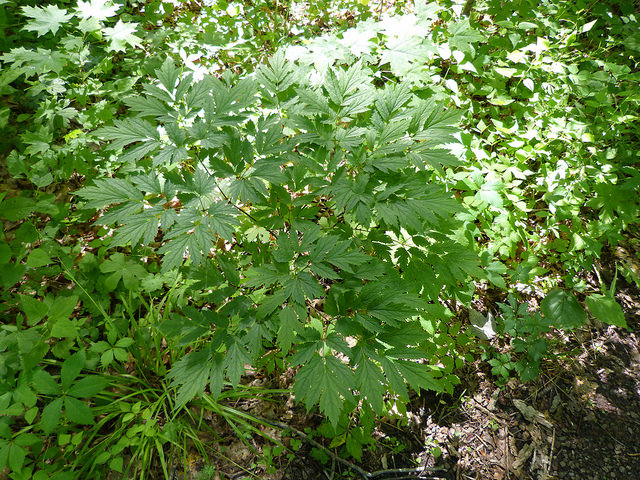
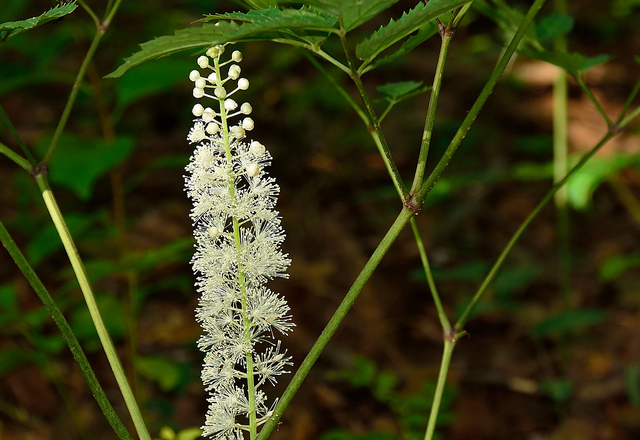
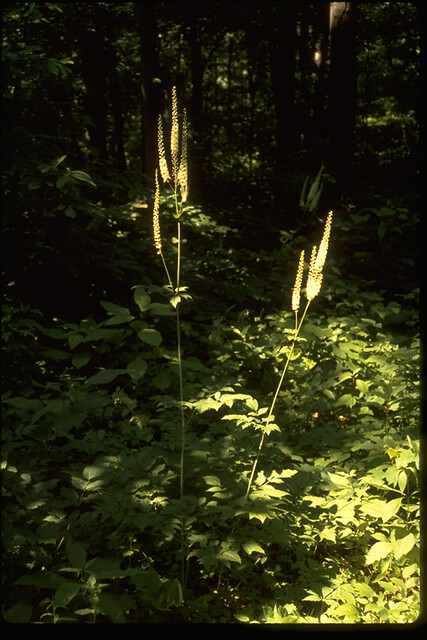


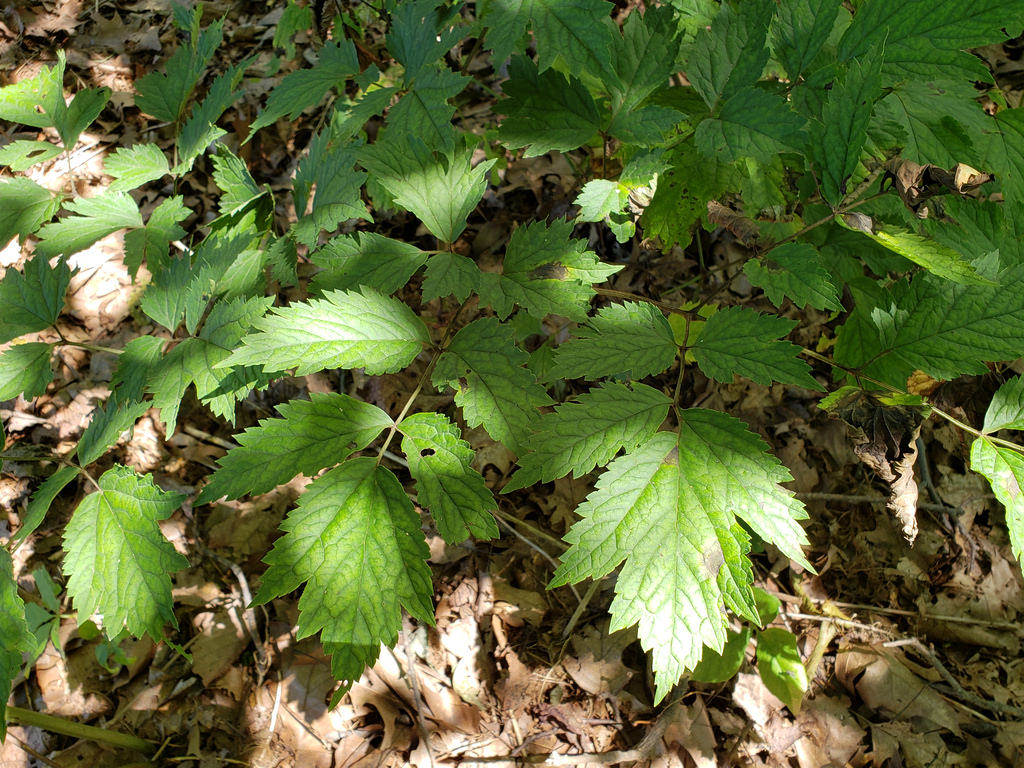
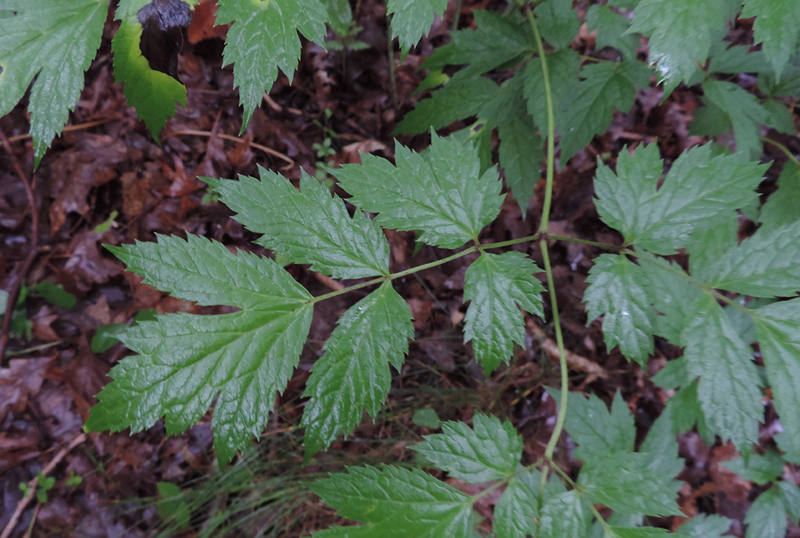

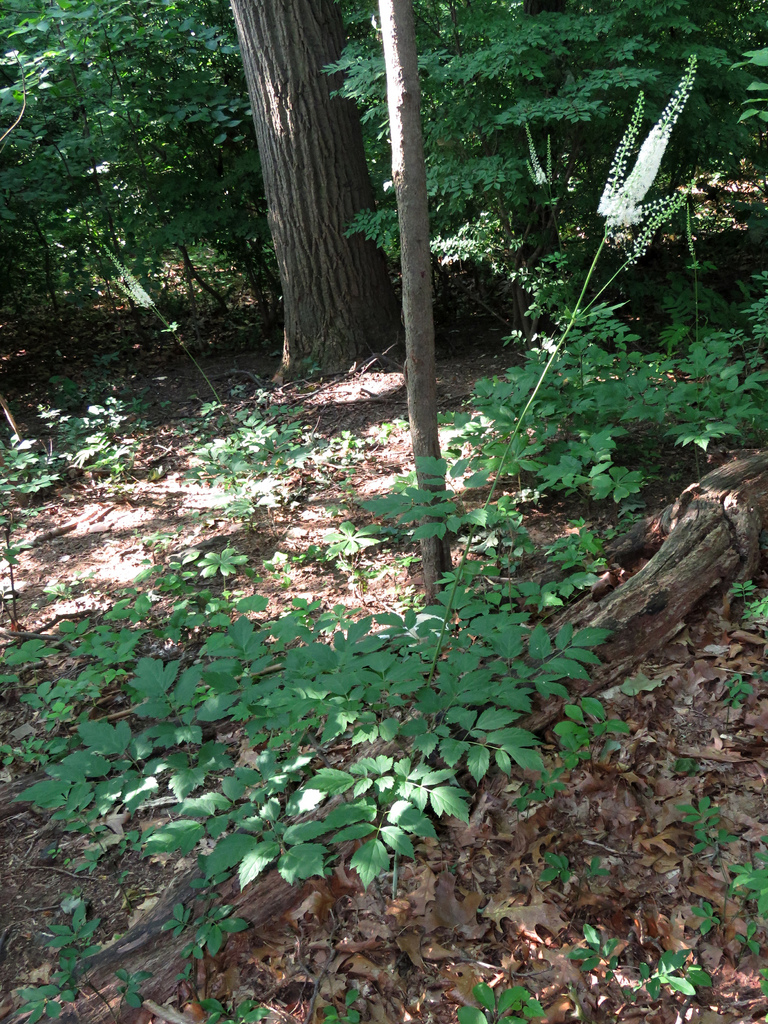
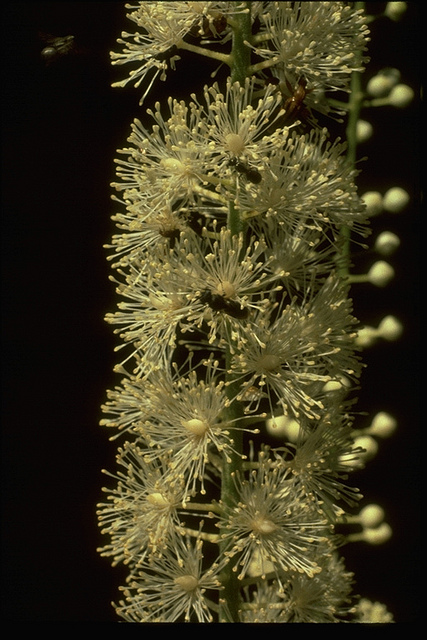
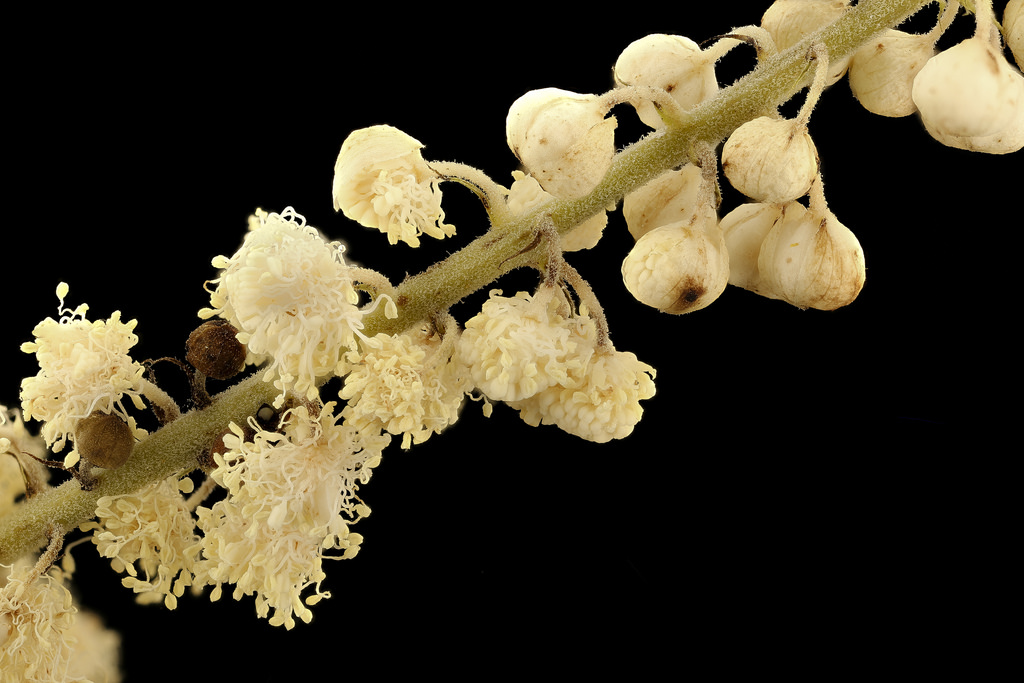
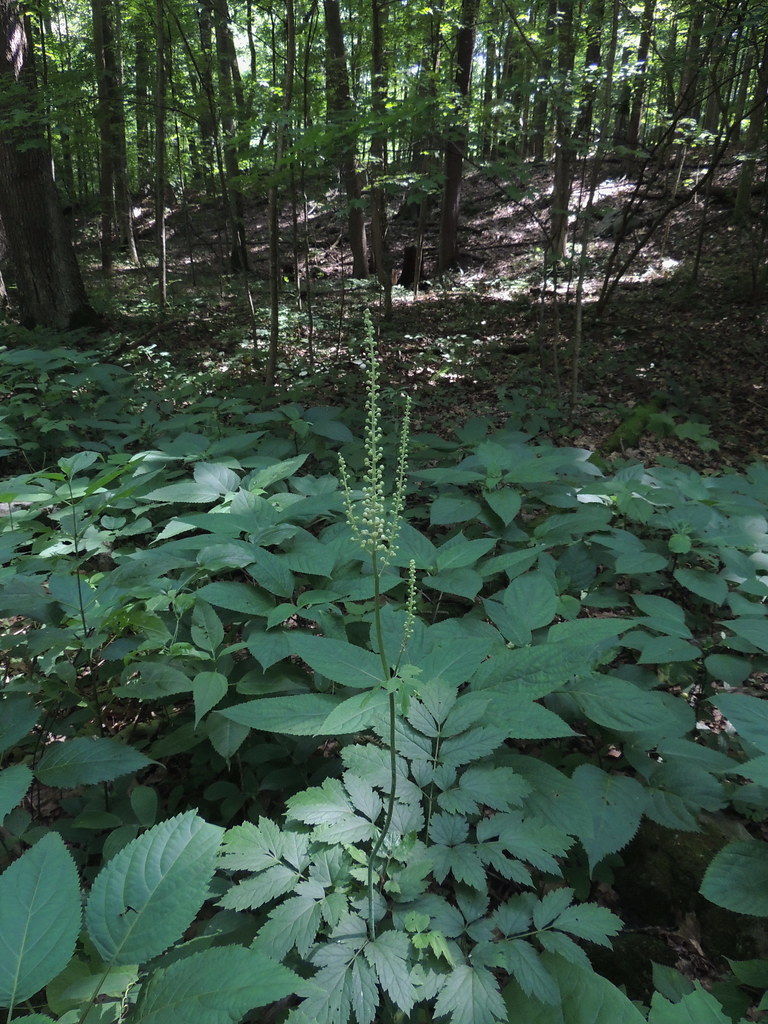
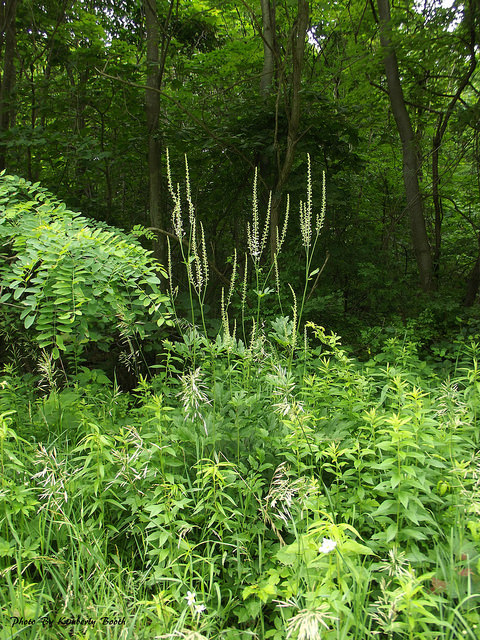
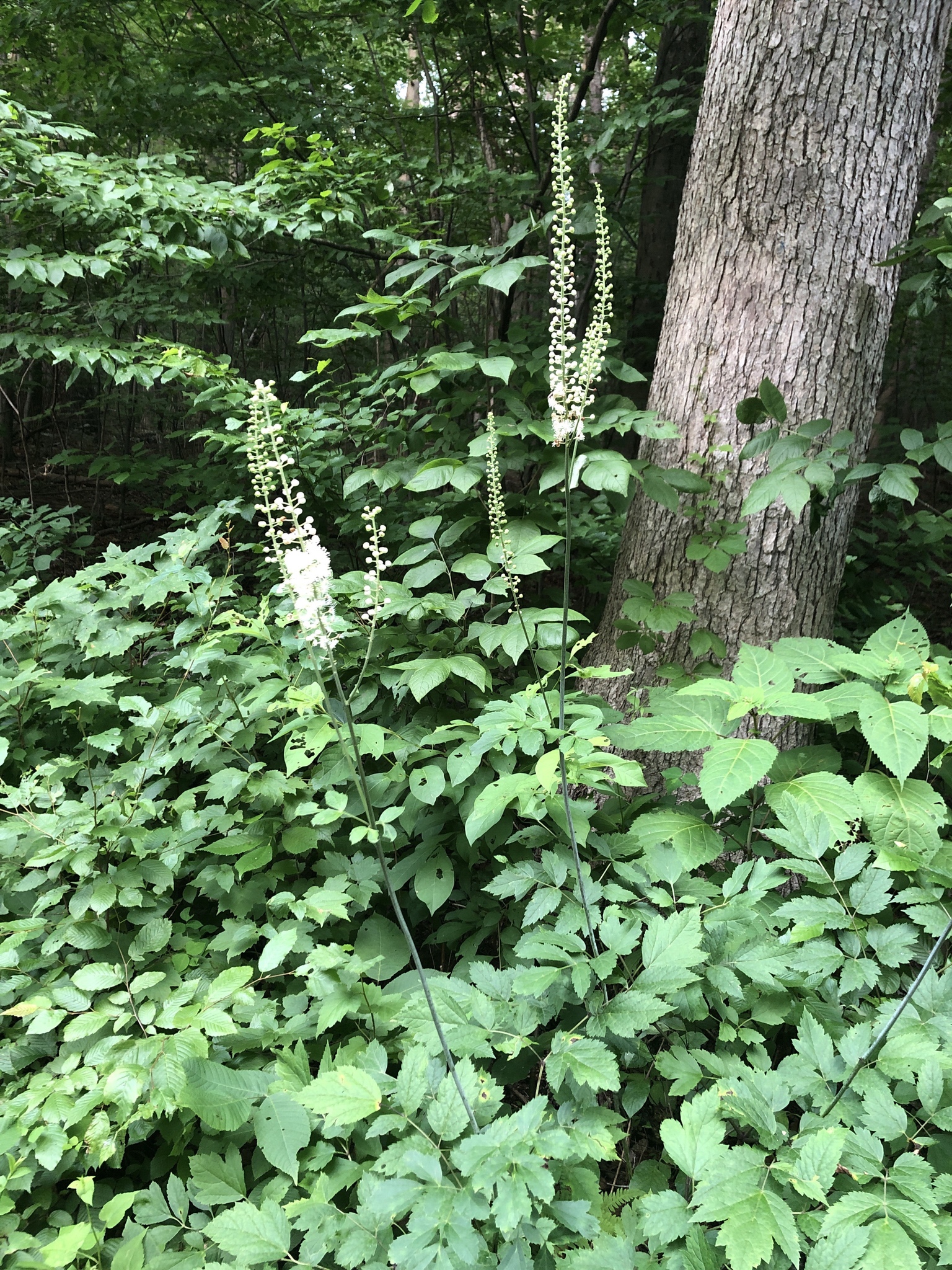

![Cimigenol, a constituent of black cohosh[34]](http://upload.wikimedia.org/wikipedia/commons/thumb/f/ff/Cimigenol_stereo.svg/180px-Cimigenol_stereo.svg.png)
![Formononetin, a constituent of methanolic black cohosh[34] extracts but not of commercially available ethanolic or isopropanolic extracts](http://upload.wikimedia.org/wikipedia/commons/thumb/7/7c/Formononetin-1.svg/180px-Formononetin-1.svg.png)



